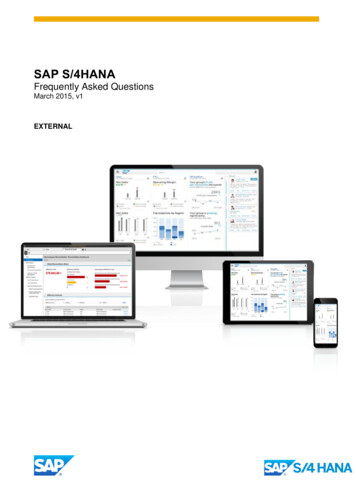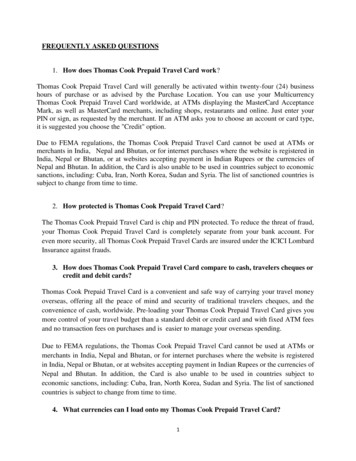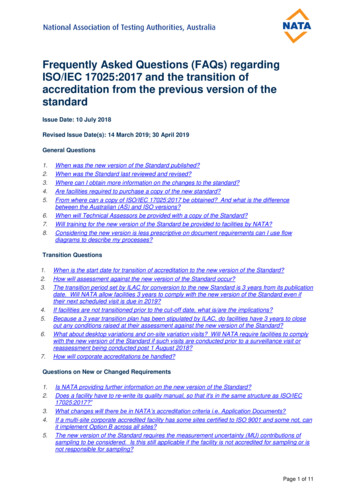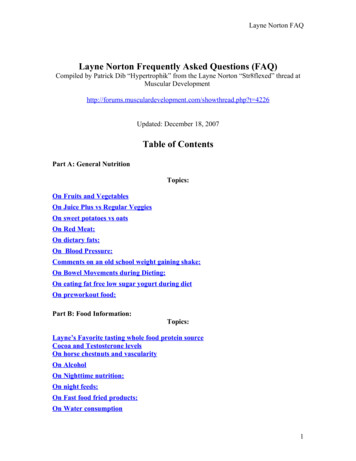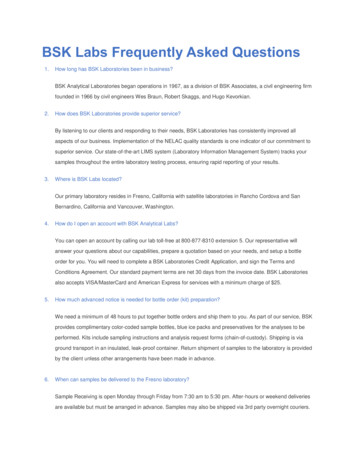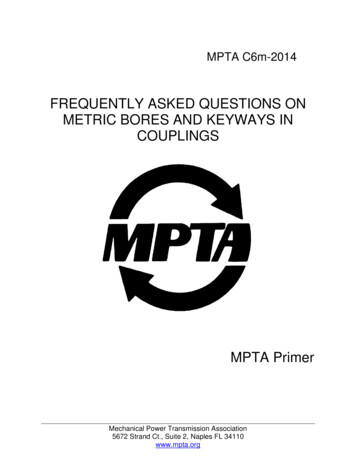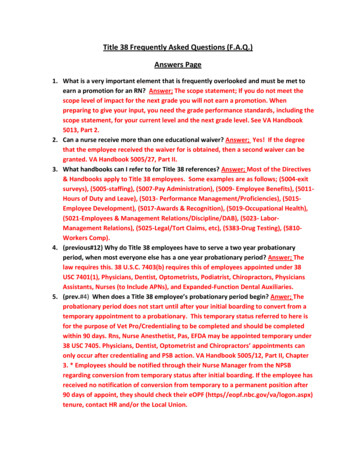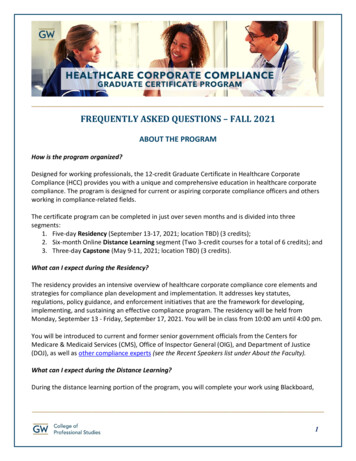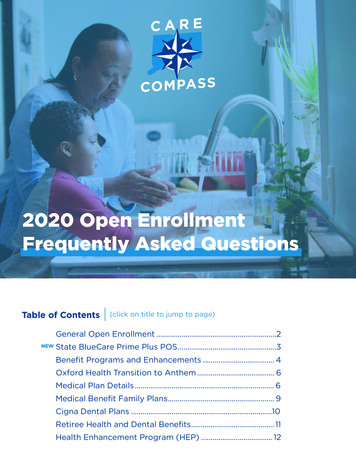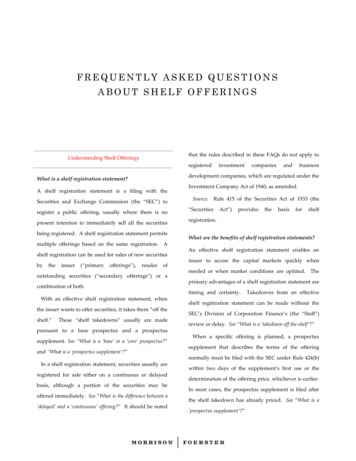
Transcription
FREQUENTLY ASKED QUESTIONSABOUT SHELF OFFERINGSthat the rules described in these FAQs do not apply toUnderstanding Shelf evelopment companies, which are regulated under theWhat is a shelf registration statement?A shelf registration statement is a filing with theSecurities and Exchange Commission (the “SEC”) toregister a public offering, usually where there is nopresent intention to immediately sell all the securitiesbeing registered. A shelf registration statement permitsInvestment Company Act of 1940, as amended.Source:Rule 415 of the Securities Act of 1933 gistration.What are the benefits of shelf registration statements?multiple offerings based on the same registration. Ashelf registration can be used for sales of new lesofoutstanding securities (“secondary offerings”) or acombination of both.An effective shelf registration statement enables anissuer to access the capital markets quickly whenneeded or when market conditions are optimal. Theprimary advantages of a shelf registration statement aretiming and certainty.With an effective shelf registration statement, whenthe issuer wants to offer securities, it takes them “off theshelf.”These “shelf takedowns” usually are madeTakedowns from an effectiveshelf registration statement can be made without theSEC’s Division of Corporation Finance’s (the “Staff”)review or delay. See “What is a ‘takedown off the shelf’?”pursuant to a base prospectus and a prospectussupplement. See “What is a ‘base’ or a ‘core’ prospectus?”and “What is a ‘prospectus supplement’?”When a specific offering is planned, a prospectussupplement that describes the terms of the offeringnormally must be filed with the SEC under Rule 424(b)In a shelf registration statement, securities usually areregistered for sale either on a continuous or delayedbasis, although a portion of the securities may beoffered immediately. See “What is the difference between a‘delayed’ and a ‘continuous’ offering?” It should be notedwithin two days of the supplement’s first use or thedetermination of the offering price, whichever is earlier.In most cases, the prospectus supplement is filed afterthe shelf takedown has already priced. See “What is a‘prospectus supplement’?”
In the case of a shelf registration statement onIn a “delayed offering,” there is no present intentionForm S-3 or Form F-3, the registration statementto offer securities at the time of effectiveness. See “Howincorporates by reference the issuer’s reports filedis a delayed primary offering typically conducted?”under the Securities Exchange Act of 1934 (theGenerally, only more seasoned issuers that are eligible“Exchange Act”) after the shelf registration statement’sto use Form S-3 or Form F-3 on a primary basis mayeffective date.This enables the issuer to use aengage in delayed primary offerings. See “Can an issuerregistration statement that became effective before theuse any registration statement form to conduct a shelfoccurrence of material developments in its business,offering?” and “What is primary eligible?”without the need to file a post-effective amendment.See “What is ‘incorporation by reference’?”Source: Rule 415(a)(1)(i) - (iv) lists the types of shelfofferings that may be effected on a delayed basis.The advantage of this type of structure is that, once anRule 415(a)(1)(ix)containstherequirementsforissuer has an effective shelf registration statement, therecontinuous offerings by any issuer that will commenceis no delay in waiting for the SEC to review thepromptly and may continue for more than 30 days.prospectus or the terms of the offering. Unlike a post-Rule 415(a)(1)(x) contains the requirements for aneffective amendment, the prospectus supplement doesimmediate, continuous, or delayed primary offering bynot have to be declared effective by the Staff.seasoned primary eligible issuers.Inaddition, the Staff historically has been less likely toreview the initial filing of a shelf registration statementHow is a delayed primary offering typically conducted?on Form S-3 or Form F-3 than other forms ofIn a delayed primary offering, the issuer typically willregistration statements. Accordingly, it is usually morefile a “core” or “base” prospectus as part of the initialtime-efficient and cost-efficient to register securitiesfiling of the registration statement. See “What is a ‘base’using a shelf registration statement.or a ‘core’ prospectus?” The actual terms and specifics ofan offering will be filed after effectiveness, in either aWhat is a “takedown off the shelf”?prospectus supplement (this is the most commonA “takedown” is an actual offering of securities from amethod),shelf registration statement that has already beenpermitted, an Exchange Act report incorporated bydeclared effective.reference into the registration statement. See “What isapost-effectiveamendmentor,where‘incorporation by reference’?” and “What is a ‘prospectusWhat is the difference between a “delayed” and a“continuous” offering?supplement’?” Issuers may engage in sales immediatelyafter effectiveness if the offering-specific information isIn a “continuous offering,” securities are offeredincluded as a part of the registration statement in thepromptly after effectiveness (within two days) and willbase prospectus or in a prospectus supplement filedcontinue to be offered in the future.under Rule 424 after effectiveness.The term“continuous” only applies to offers of the securities, notto sales of the securities; sales can be made sporadicallyover the duration of the offering.Morrison & Foerster LLP2
What is a “base” or a “core” prospectus?eligibleA “base” (also known as a “core”) prospectus is filed inissuers,” or “WKSIs”) may omit the pricing and otherorder to comply with the applicable disclosureinformation specified in Rule 430A and all otherrequirements to have a shelf registration statementinformation that is unknown or not reasonably availabledeclared effective by the Staff, with more specificto the issuer, as permitted by Rule 409. See What isinformation to follow after effectiveness in a prospectusprimary eligible?“ and “What is a ‘Well-Known Seasonedsupplement once the details about an offering areIssuer,’ or ‘WKSI’?” In addition, all offerings (other thanknown. See “What is a ‘prospectus supplement’?”mortgage-related or business combination offerings) byThe base prospectus typically contains generalinformation, such as: the types of securities to be offered; a brief summary of the issuer’s business; the use of proceeds; and a plan of distribution.The base prospectus also may contain a description of ofsellingsecurityholdersoracombination of the two; the plan of distribution; a description of the securities registered, otherthan the name or class of the securities (e.g.,“debt,” “common stock” or “preferred stock”);and the identity of other issuers (e.g., certainmajority-owned subsidiaries that may beissuer may be provided if it is expected that the baseadded later as issuers or guarantors).prospectus will be used for “marketing purposes.”required by the SEC rules, and the issuer’s signatureinformation as to whether the offering is abehalfExchange Act reports, additional information about thethe registration, required exhibits, the undertakingsseasonedprimary offering or a secondary offering oncharges. Although the base prospectus can incorporatethe so-called “Part II pages”) the estimated expenses of“well-knownRule 430B, omit:securities, may contain a ratio of earnings to fixedThe shelf registration statement also will include (in(includingWKSIs filing automatic shelf registrations may, underthe risk factors of the offering and, in the case of debtsubstantial amounts of information from the issuer’sissuersIn secondary offerings by selling security holders ofprimary eligible issuers on Form S-3 or Form F-3, theidentities of the selling security holders, all theinformation about them required by Item 507 ofRegulation S-K, and the amounts of securities to bepages.registered on their behalf may be added to theSource:General Instructions of Form S-3, GeneralInstructions of Form F-3, and Rule 430B.What information can be omitted from the baseregistration statement covering the resale of thesesecurities after effectiveness so long as: shelf registration filed by a WKSI; orprospectus?A base prospectus for immediate, continuous orthe registration is an automatically effective all of the following conditions are satisfied:delayed offerings on Form S-3 or Form F-3 by primaryMorrison & Foerster LLP3
the registration statement refers to theIn the case of a WKSI, all of the omitted informationunnamed selling security holders in amay be subsequently included in the registrationgeneric manner by identifying thestatement and the prospectus by:initial offering transaction in which a prospectus supplement;the securities were sold; a post-effective amendment; orthe initial offering of the securities is an Exchange Act report, including a currentcompleted; and thesecuritiesreport on Form 8-K, incorporated by referenceareissuedandoutstanding prior to the initial filingdate of the registration statement.into the registration statement.If the information is included in an Exchange Actreport, the issuer must file a prospectus supplementThese rules acknowledge that privately placedsecurities often are transferred after they are issued andbefore a resale registration statement is filed. In such acase, the issuer may be unaware of the identities of thenew beneficial owners and the amount of securities theyown. Filing post-effective amendments to add new orpreviously unidentified security holders can imposedelays, which these rules alleviate.under Rule 424 disclosing the Exchange Act report orreports containing such information.If the issuer includes the omitted information in aprospectus supplement, under Rule 424(c), the baseprospectus need not be re-filed with the SEC with theprospectus supplement if the base prospectus has notchanged since it was previously filed. However, manyissuers choose to re-file the base prospectus togetherThe flexibility to identify selling security holders afterwith the prospectus supplement to help ensure thateffectiveness is not available for PIPE transactionsinvestors have more convenient access to all of thewhere the securities may not have been issued in therelevant disclosure.private offering at the time the resale registrationstatement is filed. In this case, the issuer will know theexpected initial identity of, and initial amount ofsecurities held by, the selling security holders.Source: Rule 430B, Rule 424, Form S-3 and Form F-3,andSECReleaseNo.33-8591(July19,2005),Section V.B.1.b.i(C).See“What is a ‘PIPE’ transaction and how can shelf registrationWhat is a “prospectus supplement”?statements be used for such an offering?”A prospectus supplement is a document that isIn addition,issuers that are not eligible to file a primary offering ondeliveredForm S-3 or Form F-3 are not permitted to identify(Depending upon the circumstances, the delivery mayselling security holders after effectiveness, as the SECtake place with a physical document, an electronic copy,believes that these issuers are more prone to engage inor through “access equals delivery” under SECtransactions that involve heightened disclosure andRule 172.)registration issues.contains the terms of an offering that are not providedwithabaseprospectustoinvestors.The prospectus supplement typicallyin the base prospectus. See “What is a ‘base’ or a ‘core’prospectus?”Morrison & Foerster LLPThe prospectus supplement also may4
include a description of the risk factors and taxnecessarily need to be repeated in each disclosureconsequences of the specific offering, as well as adocument. As a result, a Form S-3 or Form F-3 allows adescription of the specific distribution arrangementscompany to incorporate by reference the disclosureand any planned use of the proceeds that differs fromfrom its current and future Exchange Act reports tothe description in the base prospectus.satisfy the disclosure requirements of the Form.InProspectus supplements are filed under Rule 424(b).addition, the SEC’s 2005 securities offering reformHowever, under Rule 430B and Rule 430C, prospectusamended Form S-1 and Form F-1 to permit reportingsupplements are deemed part of, and included in, thecompanies that are current in their reporting obligationsregistration statement containing the base prospectus toto incorporate by reference into their Form S-1 orwhich the prospectus supplement relates.Form F-1 information from their previously filed (butSee “Doesnot future) Exchange Act reports. In December 2015,Section 11 liability attach to a ��sSurfaceCan an issuer amend a registration statement toTransportation Act (the “FAST Act”).convert a non-shelf offering to a shelf offering?amendments required by the FAST Act, Form S-1Yes, if the conversion occurs before the registrationpermits “smaller reporting companies” (as defined instatement is declared effective.Rule 405) to incorporate by reference Exchange ActAs in the case of anon-shelf registration statement, additional securitiesalso may be added to the registration statement by apre-effective amendment. See “Can a shelf registrationstatement be converted into an unallocated shelf registrationstatement?”Source:Pursuant tofilings made after the effectiveness of the Form S-1.There are a number of SEC rules and regulations thatrestrict how incorporation by reference can be used.Source:The SEC’s incorporation by referenceregulations include Item 12(a) of Part I of Form S-3,SECComplianceandDisclosureItem 6(a) of Part I of Form F-3, Item 12(a) of Part I ofInterpretations, Securities Act Rules, Questions 212.04Form S-1, Item 5(a) of Part I of Form F-1, General(Jan. 26, 2009), available atInstruction G(4) of Form 10-K, and Rule
A shelf registration statement permits multiple offerings based on the same registration. A shelf registration can be used for sales of new securities by the issuer (primary offerings) , resales of outstanding securities (secondary offerings ) or a combination of both. With an effective shelf
